 What should be the treatment for adenoids? It is possible to quickly eliminate the symptoms of the disease in the case of surgical treatment.
What should be the treatment for adenoids? It is possible to quickly eliminate the symptoms of the disease in the case of surgical treatment.
However, operations are prescribed only with a strong proliferation of adenoid vegetations, when lymphoid tissues overlap the nasal canals by at least 50%.
In all other cases, it is possible to eliminate the signs of the disease and, accordingly, the hypertrophy of the organ with the help of physiotherapy and medications.
Pharyngeal tonsil - the forge of immunity
What are adenoids and how can they be treated? Not everyone knows that adenoids are not a disease, but an immune organ that protects the nasopharynx from the penetration of microbes, allergens, fungi and viruses. They are the first barrier on the way of the majority of pathogens entering the ENT organs with air.
In the lymphoid tissues of the pharyngeal tonsil, special antibodies are synthesized - immunoglobulins, which destroy disease-causing agents. But frequent colds, exacerbations of chronic diseases, hypovitaminosis and autoimmune disruptions negatively affect the body's resistance. A significant increase in the infectious load on the immune organ "forces" it to grow in order to increase the production of protective cells.
If the adenoid vegetation grows unhindered, over time it negatively affects the respiratory function, in particular breathing through the nose. Hypertrophied tissues block the choanas, i.e. nasal passages, as a result of which the patient begins to breathe only through the mouth. If they are not eliminated, this will lead to the development of complications, because the adenoids block not only the choanas, but also the openings of the auditory tubes.
Thus, delayed treatment of adenoid vegetations entails the development of otitis media, mastoiditis, sinusitis and other ENT diseases.
Features of therapy
Can adenoids be cured? At the initial stages of the development of pathology, symptoms can be eliminated with the help of pharmaceutical preparations and physiotherapy procedures. However, in those cases where adenoid vegetation has already provoked disturbances in nasal breathing, it is unlikely that it will be possible to do without adenotomy.
Conservative therapy is effective in the treatment of stages 1 and 2 of proliferation of lymphoid tissues in the nasopharynx.
As a rule, the treatment regimen for adenoids includes anti-inflammatory, vasoconstrictor, disinfecting and immunostimulating drugs. Medicines eliminate swelling and inflammation, due to which the volume of the pharyngeal tonsil is somewhat reduced. But in the case of a strong proliferation of adenoids, nasal preparations, rinsing solutions and systemic anti-inflammatory drugs will be ineffective.
Adenoids are formed neoplasms that do not dissolve with the use of medications. Therefore, they can be completely eliminated only in the process of surgical intervention.
However, it should be understood that fast is not always good. Complete removal of the pharyngeal tonsil leads to a decrease in immunity, which means an increase in the risk of infection of the ENT organs with pathogenic bacteria, yeast-like fungi, virions, etc.
Conservative treatment methods
How to shrink adenoids with medication? Only an integrated approach to resolving the issue allows you to achieve quick, and most importantly, positive results. It is desirable to combine drug therapy with physiotherapeutic procedures that enhance the effect of drugs and accelerate the process of their penetration into the adenoid tissues.
With a relatively small increase in the pharyngeal tonsil, the therapy regimen includes:
- vitamin and mineral complexes;
- immunocorrectors;
- antihistamines;
- homeopathic medicines;
- vasoconstrictor drops;
- antiseptic solutions;
- local antibiotics;
- medicines for rinsing the nose.
Antibiotics and antiviral agents are used only in the case of septic (infectious) inflammation of adenoid growths, which is called adenoiditis.
Of the physiotherapeutic procedures, laser therapy, cryotherapy and electrophoresis are in special demand. After 5-10 sessions, tissue regeneration improves and nasal breathing is facilitated.
Silver preparations
 Treatment of adenoids in adults may be accompanied by colloidal silver medications. Not so long ago it was proved that silver preparations have a complex disinfecting, drying, anti-inflammatory and wound-healing effect. Their use at the initial stages of the development of pathology makes it possible to reduce the volume of adenoid growths by 10-15%, which is very good.
Treatment of adenoids in adults may be accompanied by colloidal silver medications. Not so long ago it was proved that silver preparations have a complex disinfecting, drying, anti-inflammatory and wound-healing effect. Their use at the initial stages of the development of pathology makes it possible to reduce the volume of adenoid growths by 10-15%, which is very good.
Among the most effective pharmaceuticals are Protargol and Collargol. Colloidal silver forms a protective film on the surface of the nasopharyngeal mucosa, impermeable to pathogens.
This leads to a decrease in the sensitivity of the ciliated epithelium, a decrease in edema and vasoconstriction.
Important! For the treatment of adenoids, only a 1.5-2% solution of "Protargol" can be used, since high concentrations of colloidal silver cause atrophic changes in the nasal mucosa.
Disinfectants prevent the adenoid tissues from becoming inflamed and provoking complications. Therefore, they are recommended to be used for the prevention of adenoiditis in patients with 2 and 3 degrees of hypertrophy of the pharyngeal tonsil.
Inhalation
How can you quickly eliminate inflammation of the adenoids? Inhalation is one of the most effective ways to treat inflammation in the nasopharynx. At elevated temperatures, it is recommended to use not steam, but aerosol inhalers, which are called nebulizers. They convert the liquid into an aerosol, due to which the particles of the drug are very quickly absorbed by the nasal mucosa and pharyngeal tonsil.
It is worth noting that the therapeutic effect is not exerted by the procedure itself, but by the drugs that are used for inhalation. Adenoid vegetation will decrease only in case of regression of inflammation and reduction of tissue edema. For nebulizers, you can use pharmacy products that accelerate the liquefaction of mucus, destroy bacteria and promote tissue regeneration. The most effective remedies used in the treatment of adenoiditis include:
- "Dioxidin";
- "Lazolvan";
- Rotokan;
- Sinupret;
- Pulmicort.
Local treatment has a beneficial effect on the state of the respiratory system and, accordingly, the patient's well-being. If you regularly resort to physiotherapy, the symptoms of the disease can be eliminated within a few days.
Cryotherapy
 Cold treatment, or cryotherapy, not only inhibits the proliferation of adenoid tissue, but also leads to its necrotization, i.e. withering away. A painless and simple physiotherapy procedure is a good alternative to surgery, which sometimes gives complications. What is the essence of cryotherapy?
Cold treatment, or cryotherapy, not only inhibits the proliferation of adenoid tissue, but also leads to its necrotization, i.e. withering away. A painless and simple physiotherapy procedure is a good alternative to surgery, which sometimes gives complications. What is the essence of cryotherapy?
During the session, a thin tube is inserted into the patient's nasal cavity through which the pharyngeal tonsil is treated with liquid nitrogen. Under the influence of ultra-low temperatures (approximately -70 ° C), tissues freeze.
After 5-7 sessions of local cryotherapy, the nasopharyngeal tonsil becomes necrotic and disappears. You can not resort to cryotherapy for patients suffering from cold allergies, as well as women during pregnancy.
The advantage of the physiotherapeutic method for the treatment of adenoids is the absence of burns and frostbite of healthy tissues surrounding the amygdala.
In addition, cryotherapy is a bloodless and low-traumatic way to remove a hypertrophied tonsil, which can be used even as part of pediatric therapy.
Operation
How are adenoids treated? Surgical treatment is a radical way to solve the problem with adenoids. Surgery is resorted to only when drug therapy is ineffective and there are serious indications.
Adenotomy is usually prescribed for patients with:
- holding your breath during sleep;
- otitis media and tonsillitis;
- maxillofacial anomalies;
- hearing impairment;
- frequent development of acute respiratory infections (more than 5-6 times a year).
After the operation, the patient must undergo a rehabilitation course, which is aimed at restoring hearing and nasal breathing.
There are several types of surgery that are used to treat adults:
- classical adenotomy - excision of adenoid vegetations with a circular scalpel (adenotome);
- shaver adenotomy - removal of lymphoid tissues with a microdebrider, which is a device with a thin blade at the end;
- laser adenotomy - "evaporation" of the submucosal layer of the pharyngeal tonsil with a laser or excision of soft tissues with a focused beam, followed by "sealing" of blood vessels;
- cold plasma operation - bloodless removal of adenoids by plasma radiation, the temperature of which does not exceed 60 ° C.
Cold plasma coblation is the most progressive and least traumatic method of removing adenoids, during which the tissues surrounding the amygdala are practically not damaged.
Adenotomy is usually performed under general or local anesthesia. Since there are no nerve endings in the lymphoid tissues, surgery for adults is usually performed under local anesthesia, which does not create additional stress on the cardiovascular system.



